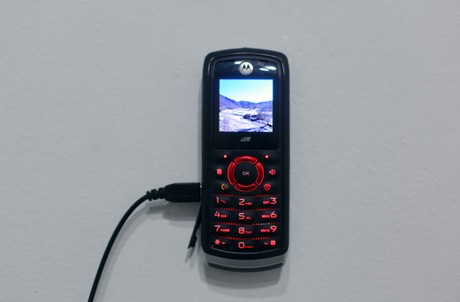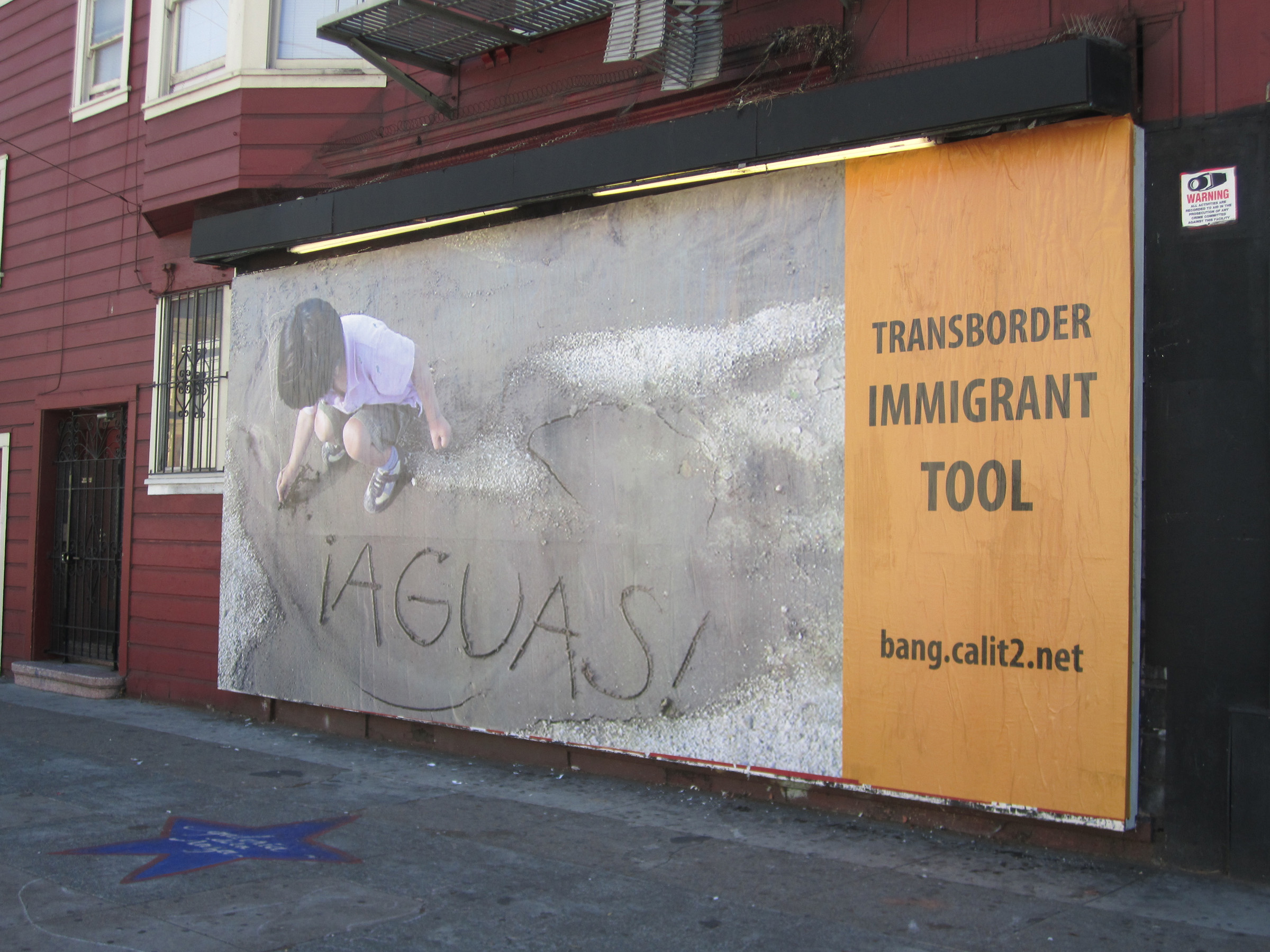This article accompanies the inclusion of Electronic Disturbance Theater 2.0 and b.a.n.g. labs' Transborder Immigrant Tool in the online exhibition Net Art Anthology.
The Transborder Immigrant Tool, developed by the Electronic Disturbance Theater (EDT) 2.0/B.A.N.G. Lab at UC San Diego between 2007 and 2012, is a straightforward app: it’s simple, equal parts code and poetry integrated into cheap Motorola burner phones that are meant to provide border-crossers, at any given border but particularly the Sonora-Arizona desert, with direction and sustenance in the form of locations of nearby water caches, first aid kits or law enforcement. The water caches are placed there by various volunteer organizations, and anyone can adapt the open source code with coordinates applicable to their own hellscape border-localities, but the artists, theorist and poets behind the tool collaborated directly with Border Angels, a non-profit organization based in San Diego working for migrant rights and prevention of immigrant deaths at the border.

Electronic Disturbance Theater 2.0/b.a.n.g. lab, Transborder Immigrant Tool (2007; photo courtesy 319 Scholes)
The Border Angels have a lot of work, and it seems like it increases daily. Deaths peaked in the 1990s, when the Clinton administration flooded the INS and the Border Patrol with cash to aggressively expand their Prevention Through Deterrence strategy, “boosting its effectiveness with state-of-the-art technologies, upgrading its fleet of vehicles and aircraft, and installing better fencing, lighting, and passive sensors.” 1 The idea was to militarize the urban border areas with the highest traffic. For Operation Gatekeeper in San Diego they deployed 1,500 agents at a time; for Operation Hold the Line in El Paso, 750; and for Operation Safeguard an increased number of agents were assigned to the Tucson urban area, effectively siphoning immigration to isolated, extremely dangerous areas.
As archaeologist and author Jason De León puts it, the Prevention Through Deterrence policy meant funneling people trying to reach the United States into the Sonora desert of Arizona and the backwoods of Texas so that they’d get hurt or die. The hope was that if enough people died, perhaps that would deter and stop others from trying.2 A 1997 report by the U.S. Government Accountability Office cited in De León’s book includes a graph that lists different metrics by which to measure the effectiveness of Prevention Through Deterrence, and one of them is the increase of migrant deaths: The numbers are apparently read as more deaths equal more deterrence.3 This policy is still in place; the U.S. Government knowingly corrals immigrants into harm’s way, deserts, rivers, steep mountains and canyons, in hopes that their very-possible death or injury will serve as deterrence to their fellow would-be border-crossers, and it has not worked.
De León and the Border Angels believe that the official number of deaths, 2,000, is vastly underestimated, and consider it to be closer to 10,000. The weaponization of wilderness turns the landscape into the “unsung hero of the border patrol”,4 a fixer that both kills and gets rid of the mess. As Amy Sara Carroll, a member of the EDT 2.0/B.A.N.G. Lab and the author of the poems in the Transborder Immigrant Tool, writes: “Ecology holds trauma and promise simultaneously, [it] becomes part of a larger built environment that regulates the policing and disciplining of ungrammatical bodies.”5 The TBT directly addresses this, the poems are read out loud by the phone to the travelers and they provide survival guidance to overcome some of the harshest circumstances. The Tool is meant as a last-stretch resource for the user to turn on once they’re in desperate straits, likely because the GPS and audio features drain the battery in an hour.
_big.jpg)
image courtesy of Ricardo Dominguez
The poems want to be welcoming rather than distracting, “to enact a place of hospitality”.6 They try to alleviate some of the hostility surrounding the traveler by conveying information with a tone that is both encouraging and soothing: “The desert catches water in unlikely places that it resists divulging. Do not expend all your energies searching for its secret stashes, but likewise do not assume that its pockets of moisture are nonexistent.” The poems offer advice on water sources (“Walk in the footprints of coyote or fox to the freshest water available”), desert storms (“Sand becomes sandpaper against the skin. Turn your back to the wind.”), rattlesnakes (“Diamondbacks, too, are creatures of habit, returning to rest stops.”) and edible cacti (“Consume the fruit of prickly pear, saguaro, organ pipe, yucca, or cholla for their mosure alone.”)7; useful and possibly life-saving words sprinkled with lyrical and kind gestures. They exist mid-way between the aesthetics of instruction manuals and folk knowledge,8 the kind of tips that only long-time desert-commuters like the people indigenous to those areas would have. The Tool is meant to be both effective and affective, an aesthetic intervention into the political and material realities of the border.
As deadly as the journey they are willing to embark on is, the mostly Mexican and Central American would-be border-crossers have it worse at their places of origin. Mexico and many other localities in Central and South America are immersed in what Sayak Valencia has defined as Gore Capitalism, for a few decades now. Invoking “gore” as in graphic violence, the term refers to the “explicit and unjustified spilling of blood, the high percentages of entrails and dismemberings frequently mixed with economic precarity, organized crime, the binary construction of gender and the predatory uses of bodies, all through the most explicit violence as a tool of necro-empowering.”9 Valencia paints this picture of life in Mexico to make clear the consequences of a detonated nation-state that mutated into a narco-state, a description that can also apply to nearby countries like Guatemala, El Salvador and Honduras. Necro-empowering indicates “the processes that transform contexts or situations of vulnerability and subalternity into the possibility of action and self-power, reconfigured in dystopian practices and perverse self-affirmation achieved through a type of violence that is profitable within the logic of capitalism.”10
This results in entire countries that, under the grinding pressure of “global hyper-consumerism, colonial after-effects, binary constructions of gender and despotical exercises of power by corrupt and authoritarian governments,”11 are transformed into narco-states ruled by a necro-politics in which government and organized crime are significantly enmeshed. The role the United States’ interventionist and extractionist policies play in all this chaos is not minor. Its sponsoring of international state-inflicted violence, its preternatural thirst for illegal drugs and weapons, and the feudal-like economic conditions it demands from less powerful and less white populations within it and around it, have created a perfect storm of genocidal proportions.12
So, the United States protects its borders, and people continue to be undeterred from trying to cross them. And yet the Transborder Immigrant Tool was conceived from a place of hope and of “commitment to global citizenship.”13 Its makers describe a world where “GPS technology is ubiquitously available and every border crosser is equipped with not only GPS, but other technological enhancements: night vision, anti-infrared clothing, Bio-Nano HyperHydration fluids or high jumping prostheses.” As the dreams of global citizenship and the “obsolescence of physical borders”14 slip further and further out of the grasp of our reality, it takes a special kind of artivism to imagine a time in which those instruments are readily available to border-crossers and not to those hunting them. Ironically, the TBT itself was never in use by actual immigrants in the desert. Perhaps this was because of the intense backlash it received during its development from people like Glenn Beck,15 or maybe because of how hard it is to make things within an academic or art environment that can ultimately be functional and scalable to the real world, specially if they are not chasing a profit.
As the current president of the United States walks amongst prototypes of the ultimate border wall and coyotes rub their hands together in anticipation of the increased fees they’ll charge for digging under or climbing over it; and as the renegotiations of NAFTA point at even worse terms for Mexico’s workers; and as the U.S. Attorney General promises more punitive measures against migrants, they are still coming. And they will keep coming, until the necessary, radical change comes that gives them back their basic human rights.
1. Attorney General of the United States. “1995 ANNUAL REPORT OF THE ATTORNEY GENERAL OF THE UNITED STATES.” Accessed May 7, 2018. https://www.justice.gov/archive/ag/annualreports/ar95/chapter3.htm.
2. Radiolab. Border Trilogy Part 2: Hold the Line | Radiolab | WNYC Studios. Accessed May 7, 2018. https://www.wnycstudios.org/story/border-trilogy-part-2-hold-line/.
3. Jason De León. The Land of Open Graves : Living and Dying on the Migrant Trail. Oakland: University of California Press, 2015, 34.
4. Radiolab. Border Trilogy Part 2: Hold the Line | Radiolab | WNYC Studios. Accessed May 7, 2018. https://www.wnycstudios.org/story/border-trilogy-part-2-hold-line/.
5. The Transborder Immigrant Tool. Ann Arbor, Michigan: The University of Michigan, 2014, 2. Accessed May 7, 2018. https://dspace.library.uvic.ca/bitstream/handle/1828/7136/ElectronicDisturbanceTheater_TransborderImmigrantTool_2014.pdf?sequence=1&isAllowed=y
6. Micha Cárdenas, Amy Sara Carroll, Ricardo Domínguez, and Brett Stalbaum. “The Transborder Immigrant Tool: Violence, Solidarity and Hope in Post-NAFTA Circuits of Bodies Electr(on)/Ic.” MobileHCI ’09 Proceedings of the 11th International Conference on Human-Computer Interaction with Mobile Devices and Services, 2009. Accessed May 7, 2018. http://citeseerx.ist.psu.edu/viewdoc/download?doi=10.1.1.561.1854&rep=rep1&type=pdf.
7. The Transborder Immigrant Tool. Ann Arbor, Michigan: The University of Michigan, 2014.
8. Marino, Mark C. “Code as Ritualized Poetry: The Tactics of the Transborder Immigrant Tool.” Digital Humanities Quarterly 007, no. 1 (July 1, 2013). Accessed May 7, 2018. http://www.digitalhumanities.org/dhq/vol/7/1/000157/000157.html.
9. Triana, Sayak Valencia. “Capitalismo Gore y necropolítica en México contemporáneo.” Relaciones Internacionales, no. 19 (2012): 84. Accessed May 7, 2018. https://revistas.uam.es/index.php/relacionesinternacionales/article/viewFile/5115/5568
10. Ibid.
11. Ibid., 25
12. The number of deaths in Mexico that are a consequence of President Felipe Calderón starting a Guerra Contra el Narco (War on Narcos) in 2007, is around 250,000. The Mérida Initiative, discussed under George W. Bush’s presidency and signed into law under Obama, had allocated US$2.5 billion to Mexico’s politicians for this conflict by 2015. The initiative also funds similar measures in Central America, and has led to the militarization of entire countries, and the rampant abuse of power and unquestioned immunity for military and law-enforcement that it entails.
13. Electronic Disturbance Theater 2.0/b.a.n.g. lab. “Border Research and the Transborder Immigrant Tool.” Media Fields Journal, no. 12 (2017), 4 http://static1.1.sqspcdn.com/static/f/707453/27403322/1483769740987/Dominguez-Formatted+1.pdf?token=P5QUtZIB945fHA%2FWqqzZV0tWlXY%3D.
14. Ibid.
15. “Fox Beck Indoctrination.” Video, 2010. http://www.criticalcommons.org/Members/markcmarino/clips/fox_beck_indoctrination_100902a.flv.


